Exploring Key Concepts in Organizational Behaviour Discussion
VerifiedAdded on 2023/06/11
|6
|1481
|309
Discussion Board Post
AI Summary
This discussion board post delves into various facets of organizational behaviour, commencing with an analysis of individual perception through the lens of contrasting reactions to a film. It further explores motivation in the workplace, highlighting companies that prioritize employee empowerment and utilize theories like Maslow's hierarchy of needs and Herzberg's two-factor theory. The discussion then transitions to leadership, differentiating between trait and behavioural theories and emphasizing the importance of developing leadership skills through training and ethical considerations. Organizational change is examined through sustaining innovations like IoT and disruptive innovations such as Airbnb and drone technology. Finally, the post underscores the significance of organizational culture, emphasizing the role of communication, interpersonal skills, and ethical practices in fostering a successful and sustainable organizational environment. The interwoven relationship between leadership, motivation, interpersonal skills, and HRM practices is highlighted as crucial for organizational growth.
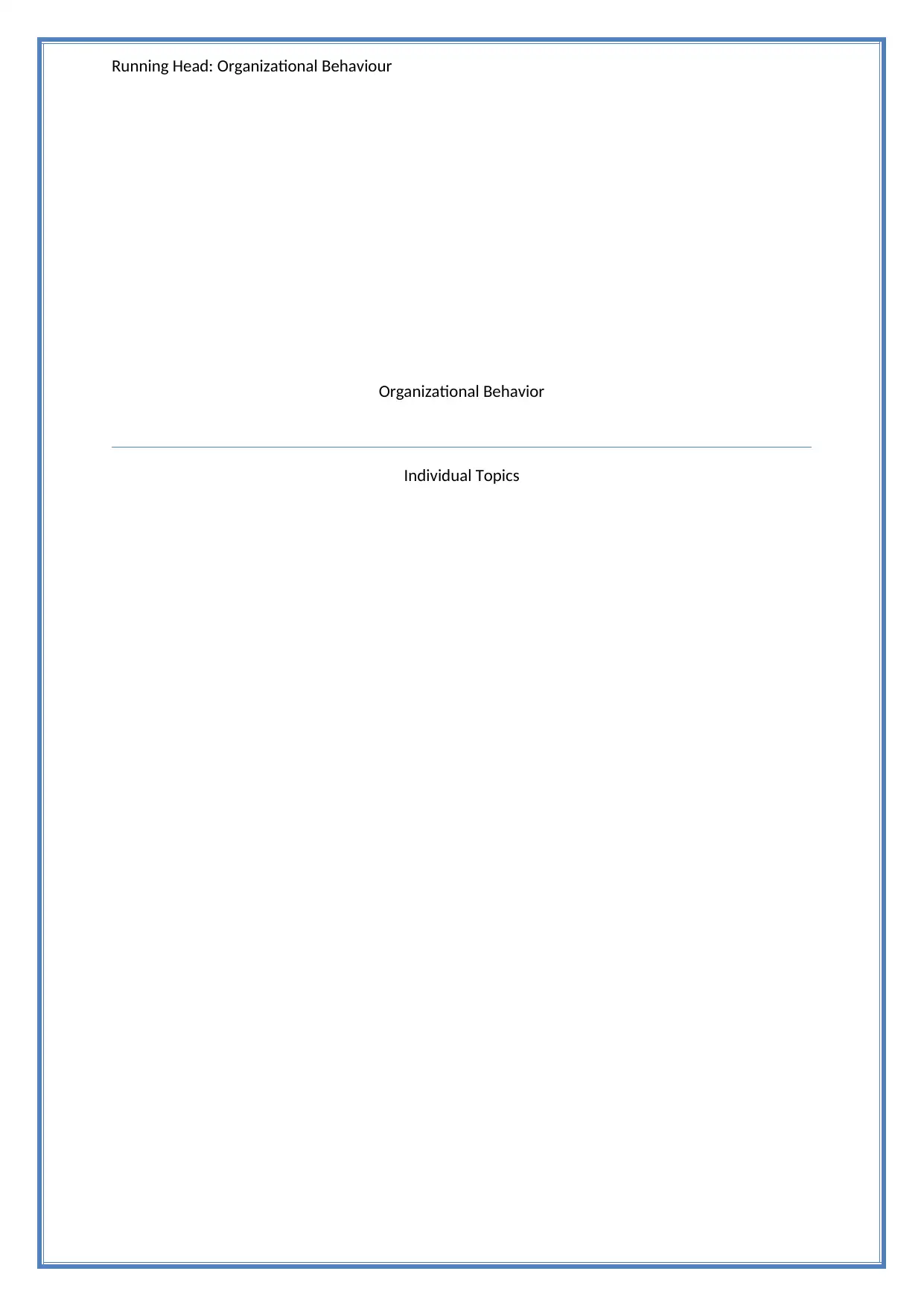
Running Head: Organizational Behaviour
Organizational Behavior
Individual Topics
Organizational Behavior
Individual Topics
Paraphrase This Document
Need a fresh take? Get an instant paraphrase of this document with our AI Paraphraser
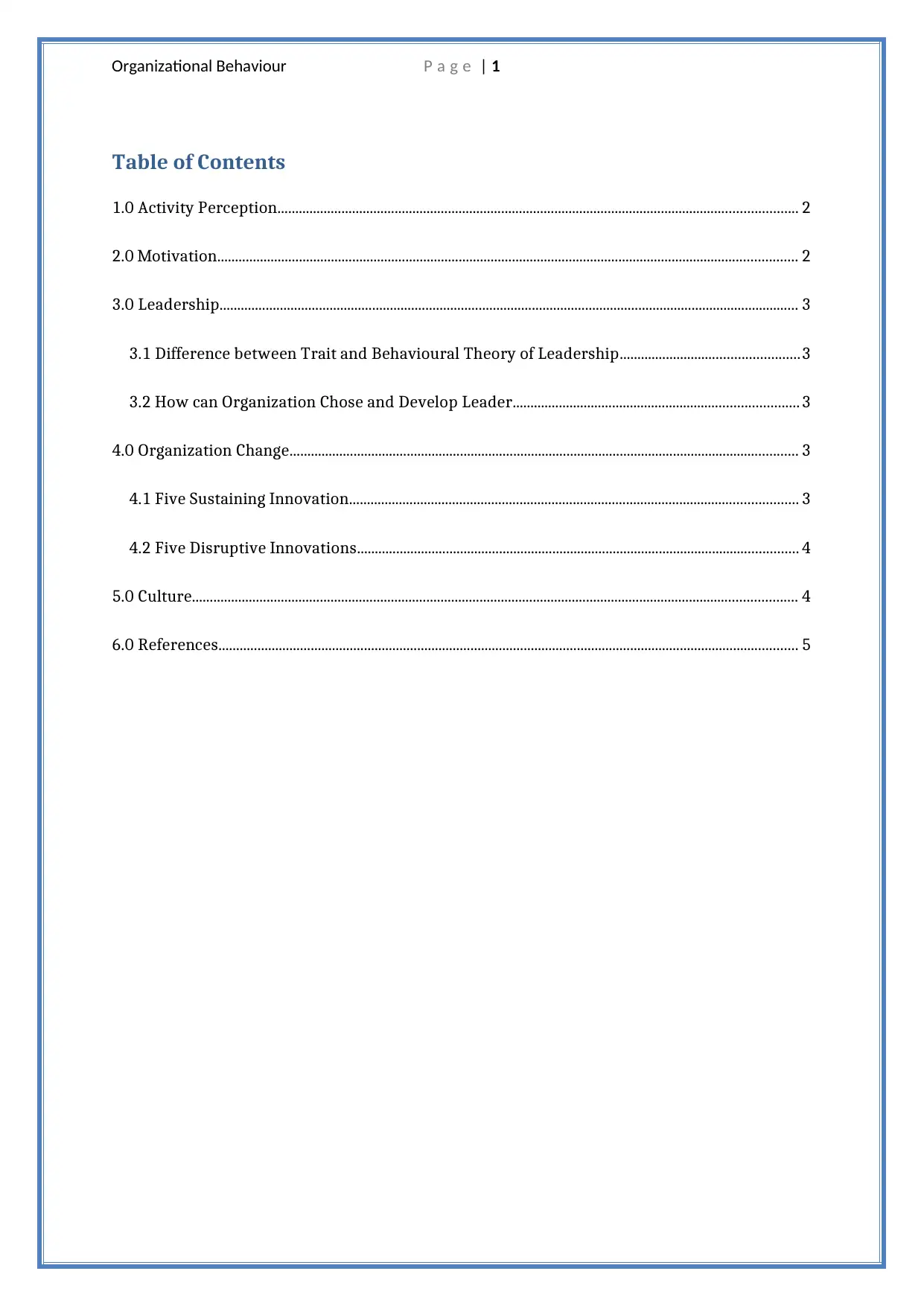
Organizational Behaviour P a g e | 1
Table of Contents
1.0 Activity Perception.................................................................................................................................................. 2
2.0 Motivation................................................................................................................................................................... 2
3.0 Leadership................................................................................................................................................................... 3
3.1 Difference between Trait and Behavioural Theory of Leadership..................................................3
3.2 How can Organization Chose and Develop Leader................................................................................3
4.0 Organization Change............................................................................................................................................... 3
4.1 Five Sustaining Innovation.............................................................................................................................. 3
4.2 Five Disruptive Innovations............................................................................................................................ 4
5.0 Culture.......................................................................................................................................................................... 4
6.0 References................................................................................................................................................................... 5
Table of Contents
1.0 Activity Perception.................................................................................................................................................. 2
2.0 Motivation................................................................................................................................................................... 2
3.0 Leadership................................................................................................................................................................... 3
3.1 Difference between Trait and Behavioural Theory of Leadership..................................................3
3.2 How can Organization Chose and Develop Leader................................................................................3
4.0 Organization Change............................................................................................................................................... 3
4.1 Five Sustaining Innovation.............................................................................................................................. 3
4.2 Five Disruptive Innovations............................................................................................................................ 4
5.0 Culture.......................................................................................................................................................................... 4
6.0 References................................................................................................................................................................... 5
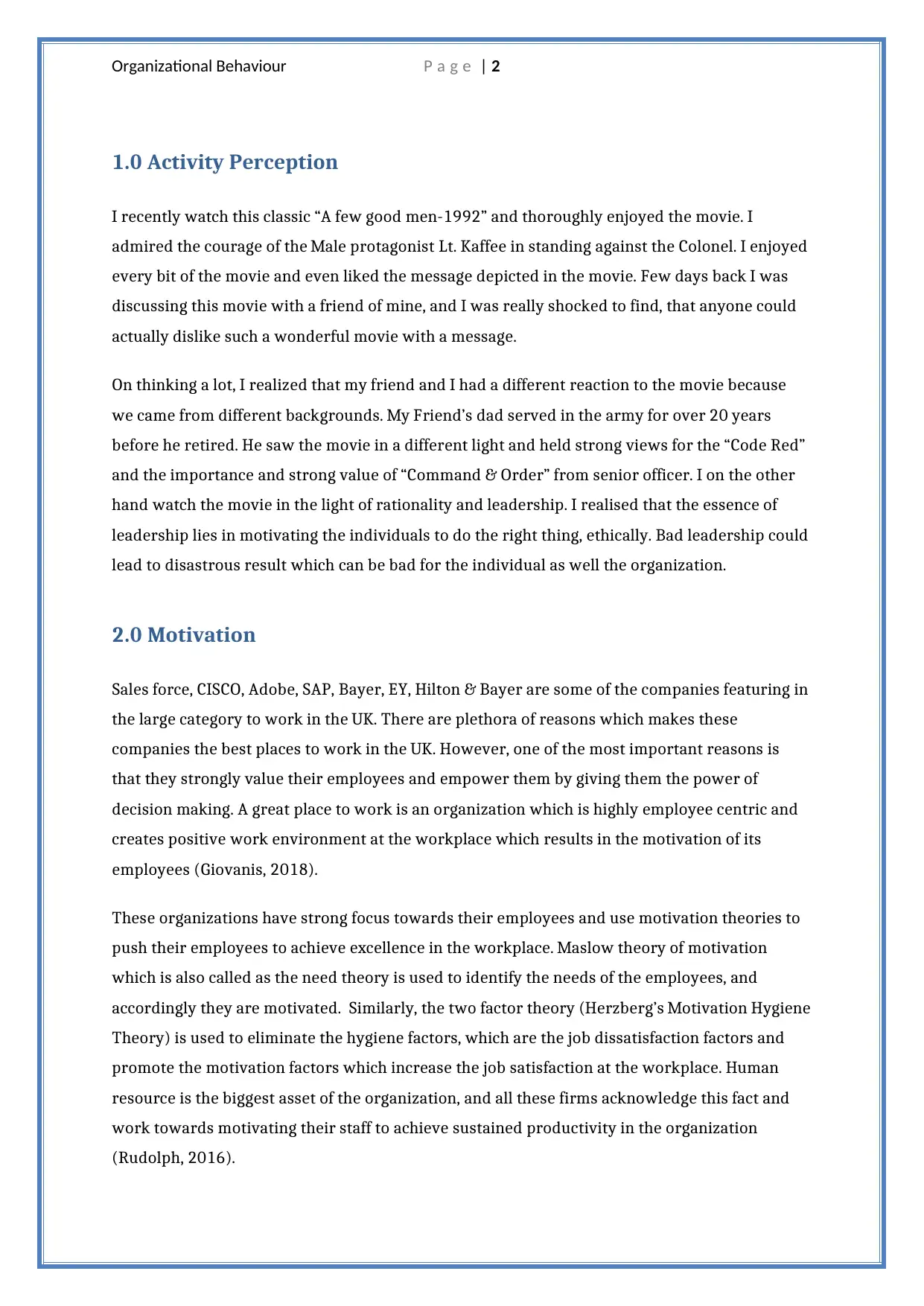
Organizational Behaviour P a g e | 2
1.0 Activity Perception
I recently watch this classic “A few good men-1992” and thoroughly enjoyed the movie. I
admired the courage of the Male protagonist Lt. Kaffee in standing against the Colonel. I enjoyed
every bit of the movie and even liked the message depicted in the movie. Few days back I was
discussing this movie with a friend of mine, and I was really shocked to find, that anyone could
actually dislike such a wonderful movie with a message.
On thinking a lot, I realized that my friend and I had a different reaction to the movie because
we came from different backgrounds. My Friend’s dad served in the army for over 20 years
before he retired. He saw the movie in a different light and held strong views for the “Code Red”
and the importance and strong value of “Command & Order” from senior officer. I on the other
hand watch the movie in the light of rationality and leadership. I realised that the essence of
leadership lies in motivating the individuals to do the right thing, ethically. Bad leadership could
lead to disastrous result which can be bad for the individual as well the organization.
2.0 Motivation
Sales force, CISCO, Adobe, SAP, Bayer, EY, Hilton & Bayer are some of the companies featuring in
the large category to work in the UK. There are plethora of reasons which makes these
companies the best places to work in the UK. However, one of the most important reasons is
that they strongly value their employees and empower them by giving them the power of
decision making. A great place to work is an organization which is highly employee centric and
creates positive work environment at the workplace which results in the motivation of its
employees (Giovanis, 2018).
These organizations have strong focus towards their employees and use motivation theories to
push their employees to achieve excellence in the workplace. Maslow theory of motivation
which is also called as the need theory is used to identify the needs of the employees, and
accordingly they are motivated. Similarly, the two factor theory (Herzberg’s Motivation Hygiene
Theory) is used to eliminate the hygiene factors, which are the job dissatisfaction factors and
promote the motivation factors which increase the job satisfaction at the workplace. Human
resource is the biggest asset of the organization, and all these firms acknowledge this fact and
work towards motivating their staff to achieve sustained productivity in the organization
(Rudolph, 2016).
1.0 Activity Perception
I recently watch this classic “A few good men-1992” and thoroughly enjoyed the movie. I
admired the courage of the Male protagonist Lt. Kaffee in standing against the Colonel. I enjoyed
every bit of the movie and even liked the message depicted in the movie. Few days back I was
discussing this movie with a friend of mine, and I was really shocked to find, that anyone could
actually dislike such a wonderful movie with a message.
On thinking a lot, I realized that my friend and I had a different reaction to the movie because
we came from different backgrounds. My Friend’s dad served in the army for over 20 years
before he retired. He saw the movie in a different light and held strong views for the “Code Red”
and the importance and strong value of “Command & Order” from senior officer. I on the other
hand watch the movie in the light of rationality and leadership. I realised that the essence of
leadership lies in motivating the individuals to do the right thing, ethically. Bad leadership could
lead to disastrous result which can be bad for the individual as well the organization.
2.0 Motivation
Sales force, CISCO, Adobe, SAP, Bayer, EY, Hilton & Bayer are some of the companies featuring in
the large category to work in the UK. There are plethora of reasons which makes these
companies the best places to work in the UK. However, one of the most important reasons is
that they strongly value their employees and empower them by giving them the power of
decision making. A great place to work is an organization which is highly employee centric and
creates positive work environment at the workplace which results in the motivation of its
employees (Giovanis, 2018).
These organizations have strong focus towards their employees and use motivation theories to
push their employees to achieve excellence in the workplace. Maslow theory of motivation
which is also called as the need theory is used to identify the needs of the employees, and
accordingly they are motivated. Similarly, the two factor theory (Herzberg’s Motivation Hygiene
Theory) is used to eliminate the hygiene factors, which are the job dissatisfaction factors and
promote the motivation factors which increase the job satisfaction at the workplace. Human
resource is the biggest asset of the organization, and all these firms acknowledge this fact and
work towards motivating their staff to achieve sustained productivity in the organization
(Rudolph, 2016).
⊘ This is a preview!⊘
Do you want full access?
Subscribe today to unlock all pages.

Trusted by 1+ million students worldwide
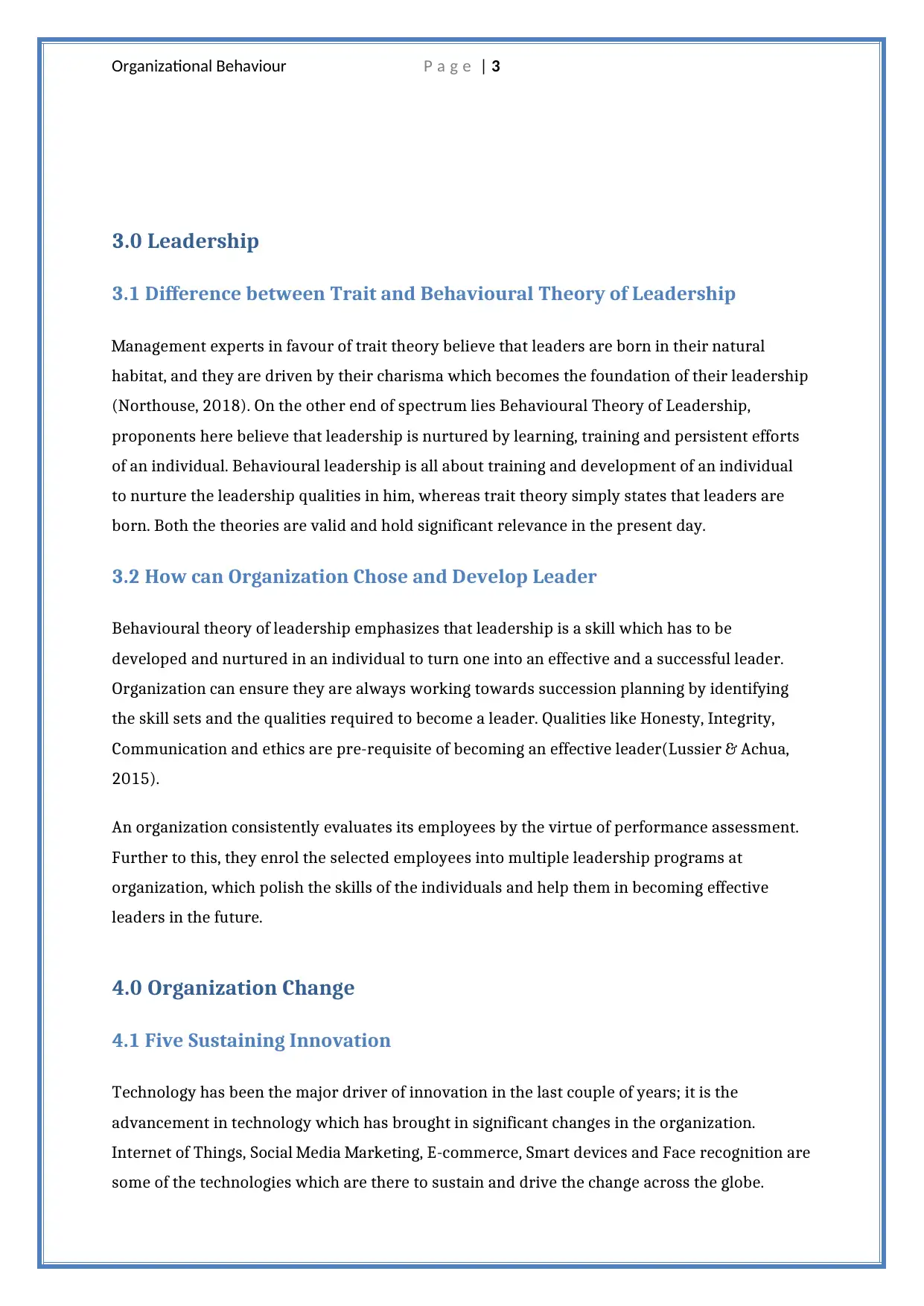
Organizational Behaviour P a g e | 3
3.0 Leadership
3.1 Difference between Trait and Behavioural Theory of Leadership
Management experts in favour of trait theory believe that leaders are born in their natural
habitat, and they are driven by their charisma which becomes the foundation of their leadership
(Northouse, 2018). On the other end of spectrum lies Behavioural Theory of Leadership,
proponents here believe that leadership is nurtured by learning, training and persistent efforts
of an individual. Behavioural leadership is all about training and development of an individual
to nurture the leadership qualities in him, whereas trait theory simply states that leaders are
born. Both the theories are valid and hold significant relevance in the present day.
3.2 How can Organization Chose and Develop Leader
Behavioural theory of leadership emphasizes that leadership is a skill which has to be
developed and nurtured in an individual to turn one into an effective and a successful leader.
Organization can ensure they are always working towards succession planning by identifying
the skill sets and the qualities required to become a leader. Qualities like Honesty, Integrity,
Communication and ethics are pre-requisite of becoming an effective leader(Lussier & Achua,
2015).
An organization consistently evaluates its employees by the virtue of performance assessment.
Further to this, they enrol the selected employees into multiple leadership programs at
organization, which polish the skills of the individuals and help them in becoming effective
leaders in the future.
4.0 Organization Change
4.1 Five Sustaining Innovation
Technology has been the major driver of innovation in the last couple of years; it is the
advancement in technology which has brought in significant changes in the organization.
Internet of Things, Social Media Marketing, E-commerce, Smart devices and Face recognition are
some of the technologies which are there to sustain and drive the change across the globe.
3.0 Leadership
3.1 Difference between Trait and Behavioural Theory of Leadership
Management experts in favour of trait theory believe that leaders are born in their natural
habitat, and they are driven by their charisma which becomes the foundation of their leadership
(Northouse, 2018). On the other end of spectrum lies Behavioural Theory of Leadership,
proponents here believe that leadership is nurtured by learning, training and persistent efforts
of an individual. Behavioural leadership is all about training and development of an individual
to nurture the leadership qualities in him, whereas trait theory simply states that leaders are
born. Both the theories are valid and hold significant relevance in the present day.
3.2 How can Organization Chose and Develop Leader
Behavioural theory of leadership emphasizes that leadership is a skill which has to be
developed and nurtured in an individual to turn one into an effective and a successful leader.
Organization can ensure they are always working towards succession planning by identifying
the skill sets and the qualities required to become a leader. Qualities like Honesty, Integrity,
Communication and ethics are pre-requisite of becoming an effective leader(Lussier & Achua,
2015).
An organization consistently evaluates its employees by the virtue of performance assessment.
Further to this, they enrol the selected employees into multiple leadership programs at
organization, which polish the skills of the individuals and help them in becoming effective
leaders in the future.
4.0 Organization Change
4.1 Five Sustaining Innovation
Technology has been the major driver of innovation in the last couple of years; it is the
advancement in technology which has brought in significant changes in the organization.
Internet of Things, Social Media Marketing, E-commerce, Smart devices and Face recognition are
some of the technologies which are there to sustain and drive the change across the globe.
Paraphrase This Document
Need a fresh take? Get an instant paraphrase of this document with our AI Paraphraser
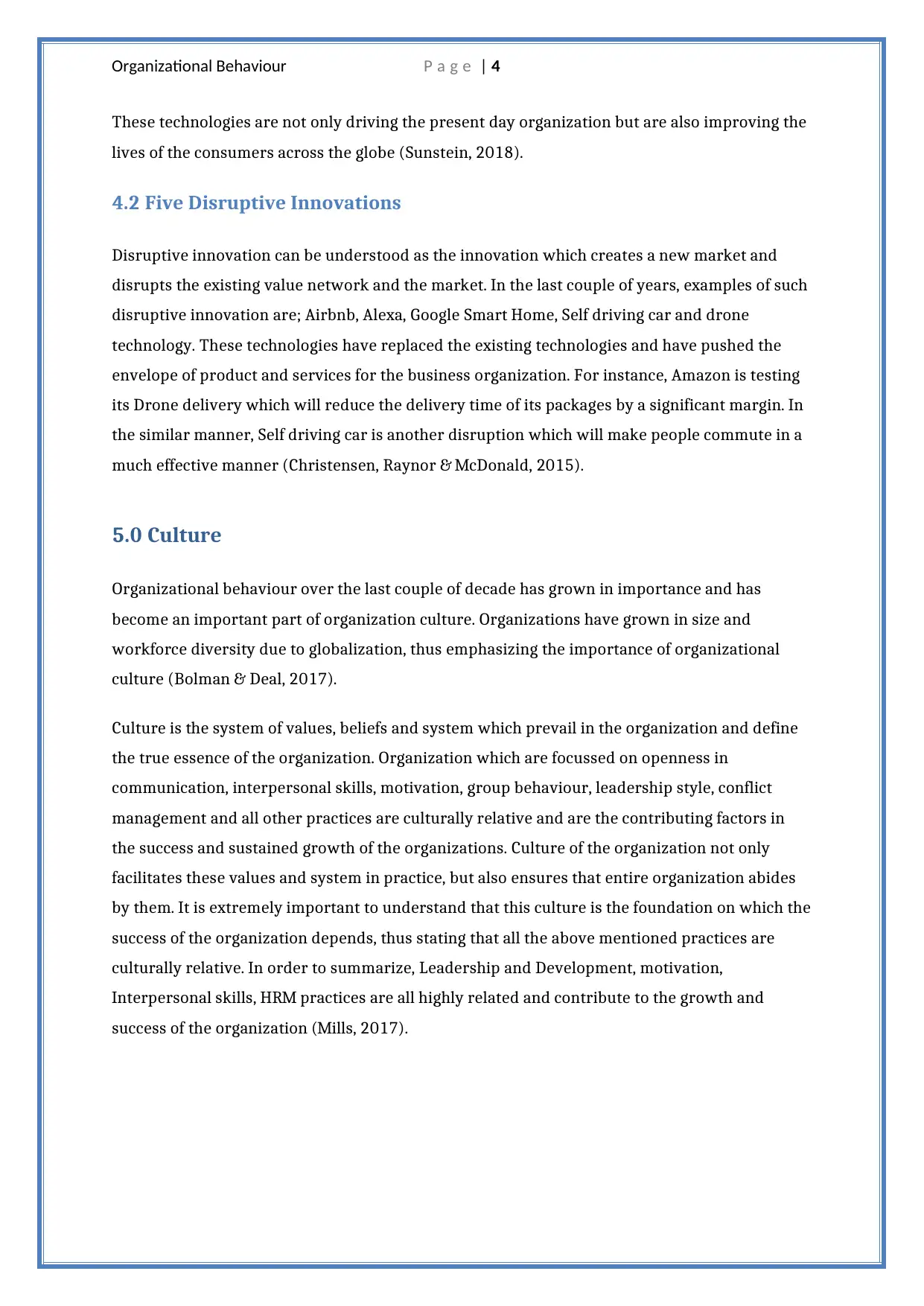
Organizational Behaviour P a g e | 4
These technologies are not only driving the present day organization but are also improving the
lives of the consumers across the globe (Sunstein, 2018).
4.2 Five Disruptive Innovations
Disruptive innovation can be understood as the innovation which creates a new market and
disrupts the existing value network and the market. In the last couple of years, examples of such
disruptive innovation are; Airbnb, Alexa, Google Smart Home, Self driving car and drone
technology. These technologies have replaced the existing technologies and have pushed the
envelope of product and services for the business organization. For instance, Amazon is testing
its Drone delivery which will reduce the delivery time of its packages by a significant margin. In
the similar manner, Self driving car is another disruption which will make people commute in a
much effective manner (Christensen, Raynor & McDonald, 2015).
5.0 Culture
Organizational behaviour over the last couple of decade has grown in importance and has
become an important part of organization culture. Organizations have grown in size and
workforce diversity due to globalization, thus emphasizing the importance of organizational
culture (Bolman & Deal, 2017).
Culture is the system of values, beliefs and system which prevail in the organization and define
the true essence of the organization. Organization which are focussed on openness in
communication, interpersonal skills, motivation, group behaviour, leadership style, conflict
management and all other practices are culturally relative and are the contributing factors in
the success and sustained growth of the organizations. Culture of the organization not only
facilitates these values and system in practice, but also ensures that entire organization abides
by them. It is extremely important to understand that this culture is the foundation on which the
success of the organization depends, thus stating that all the above mentioned practices are
culturally relative. In order to summarize, Leadership and Development, motivation,
Interpersonal skills, HRM practices are all highly related and contribute to the growth and
success of the organization (Mills, 2017).
These technologies are not only driving the present day organization but are also improving the
lives of the consumers across the globe (Sunstein, 2018).
4.2 Five Disruptive Innovations
Disruptive innovation can be understood as the innovation which creates a new market and
disrupts the existing value network and the market. In the last couple of years, examples of such
disruptive innovation are; Airbnb, Alexa, Google Smart Home, Self driving car and drone
technology. These technologies have replaced the existing technologies and have pushed the
envelope of product and services for the business organization. For instance, Amazon is testing
its Drone delivery which will reduce the delivery time of its packages by a significant margin. In
the similar manner, Self driving car is another disruption which will make people commute in a
much effective manner (Christensen, Raynor & McDonald, 2015).
5.0 Culture
Organizational behaviour over the last couple of decade has grown in importance and has
become an important part of organization culture. Organizations have grown in size and
workforce diversity due to globalization, thus emphasizing the importance of organizational
culture (Bolman & Deal, 2017).
Culture is the system of values, beliefs and system which prevail in the organization and define
the true essence of the organization. Organization which are focussed on openness in
communication, interpersonal skills, motivation, group behaviour, leadership style, conflict
management and all other practices are culturally relative and are the contributing factors in
the success and sustained growth of the organizations. Culture of the organization not only
facilitates these values and system in practice, but also ensures that entire organization abides
by them. It is extremely important to understand that this culture is the foundation on which the
success of the organization depends, thus stating that all the above mentioned practices are
culturally relative. In order to summarize, Leadership and Development, motivation,
Interpersonal skills, HRM practices are all highly related and contribute to the growth and
success of the organization (Mills, 2017).
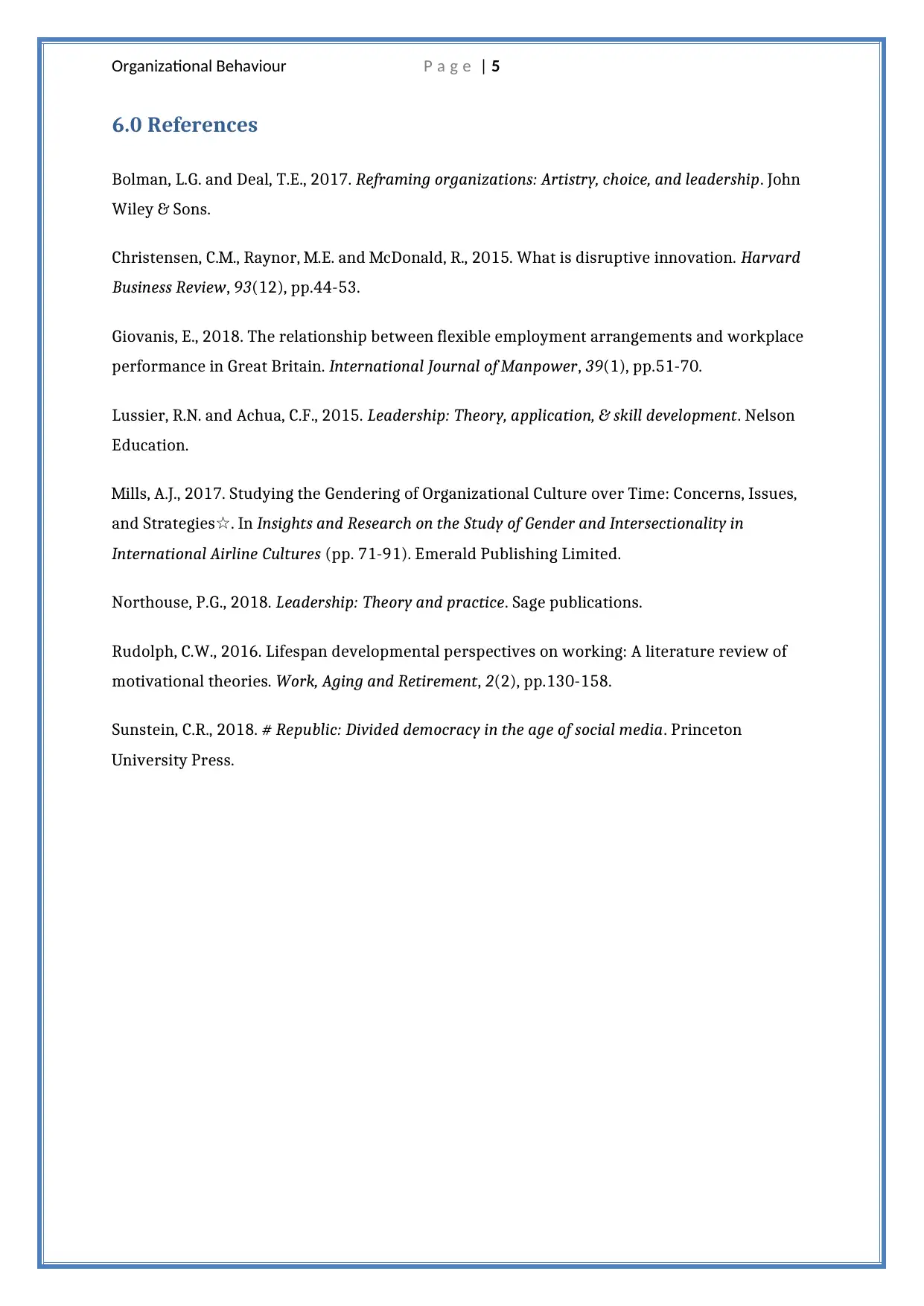
Organizational Behaviour P a g e | 5
6.0 References
Bolman, L.G. and Deal, T.E., 2017. Reframing organizations: Artistry, choice, and leadership. John
Wiley & Sons.
Christensen, C.M., Raynor, M.E. and McDonald, R., 2015. What is disruptive innovation. Harvard
Business Review, 93(12), pp.44-53.
Giovanis, E., 2018. The relationship between flexible employment arrangements and workplace
performance in Great Britain. International Journal of Manpower, 39(1), pp.51-70.
Lussier, R.N. and Achua, C.F., 2015. Leadership: Theory, application, & skill development. Nelson
Education.
Mills, A.J., 2017. Studying the Gendering of Organizational Culture over Time: Concerns, Issues,
and Strategies☆. In Insights and Research on the Study of Gender and Intersectionality in
International Airline Cultures (pp. 71-91). Emerald Publishing Limited.
Northouse, P.G., 2018. Leadership: Theory and practice. Sage publications.
Rudolph, C.W., 2016. Lifespan developmental perspectives on working: A literature review of
motivational theories. Work, Aging and Retirement, 2(2), pp.130-158.
Sunstein, C.R., 2018. # Republic: Divided democracy in the age of social media. Princeton
University Press.
6.0 References
Bolman, L.G. and Deal, T.E., 2017. Reframing organizations: Artistry, choice, and leadership. John
Wiley & Sons.
Christensen, C.M., Raynor, M.E. and McDonald, R., 2015. What is disruptive innovation. Harvard
Business Review, 93(12), pp.44-53.
Giovanis, E., 2018. The relationship between flexible employment arrangements and workplace
performance in Great Britain. International Journal of Manpower, 39(1), pp.51-70.
Lussier, R.N. and Achua, C.F., 2015. Leadership: Theory, application, & skill development. Nelson
Education.
Mills, A.J., 2017. Studying the Gendering of Organizational Culture over Time: Concerns, Issues,
and Strategies☆. In Insights and Research on the Study of Gender and Intersectionality in
International Airline Cultures (pp. 71-91). Emerald Publishing Limited.
Northouse, P.G., 2018. Leadership: Theory and practice. Sage publications.
Rudolph, C.W., 2016. Lifespan developmental perspectives on working: A literature review of
motivational theories. Work, Aging and Retirement, 2(2), pp.130-158.
Sunstein, C.R., 2018. # Republic: Divided democracy in the age of social media. Princeton
University Press.
⊘ This is a preview!⊘
Do you want full access?
Subscribe today to unlock all pages.

Trusted by 1+ million students worldwide
1 out of 6
Related Documents
Your All-in-One AI-Powered Toolkit for Academic Success.
+13062052269
info@desklib.com
Available 24*7 on WhatsApp / Email
![[object Object]](/_next/static/media/star-bottom.7253800d.svg)
Unlock your academic potential
Copyright © 2020–2025 A2Z Services. All Rights Reserved. Developed and managed by ZUCOL.





